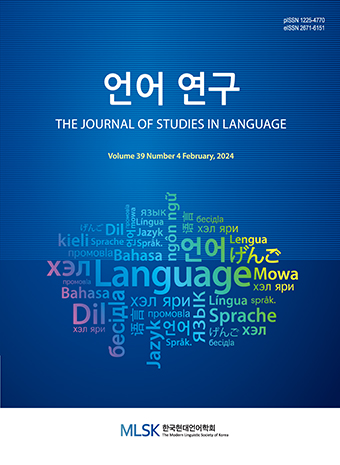Research Article
Abstract
References
Information
While phonetic neutralization in different morphophonological environments is discussed in previous studies (Kisseberth, 1969), Korean palatalization is known as an uncommon phonological phenomenon because the morpheme boundary plays a role. This study investigates whether morpheme boundaries also affect allophonic /n/ palatalization in Korean and demonstrates that morpheme boundaries contribute to allophonic variation. By using ultrasound imaging of four native Korean speakers, this study examines differences in /n/ palatalization between two morphologically different sets of words in Korean – tautomorphemic words (e.g., /koni/ ‘swan’) and heteromorphemic words (e.g., /mun#i/ ‘door + NOM (nominative marker)’). Comparisons of the degree of palatalization before /i/ show significant differences among different morphological environments. The results from this study support Cho (1998; 2001)’s claim on boundary effect in Korean /n/ palatalization and suggest that there are individual differences in distinguishing various morphological conditions.
- Ahn, S.-C. 1985. The Interplay of Phonology and Morphology in Korean. PhD Dissertation. University of Illinois at Urbana-Champaign.
- Archangeli, D. and J. Berry. 2010. Different dark and light /l/s: English & Georgian. UltraFest V.
- Archangeli, D., S. Johnston, J-H. Sung, M. Fisher, M. Hammond, and A. Carnie. 2014. Articulation and Neutralization: A Preliminary Study of Lenition in Scottish Gaelic. Proceedings of Interspeech 2014. 1683-1687.
- Baker, A. 2005. Palatoglossatron 1.0. University of Arizona.
- Bennett, R., M. Ní Chiosáin, J. Padgett, and G. McGure. 2018. An Ultrasound Study of Connemara Irish Palatalization and Velarization. Journal of the International Phonetic Association 48, 261-304. 10.1017/S0025100317000494
- Cho, T. 1998. Intergestural Timing and Overlap in Korean Palatalization: An Optimality-theoretic Approach. In D. Silva (ed.), Japanese/Korean Linguistics 8, Stanford: CSLI Publications, 261-276.
- Cho, T. 2001. Effects of Morpheme Boundaries on Intergestural Timing: Evidence from Korean. Phonetica 58, 129-162. 10.1159/000056196 11423783
- Davidson, L. 2006. Comparing Tongue Shapes from Ultrasound Imaging Using Smoothing Spline Analysis of Variance. Journal of Acoustical Society of America 120, 407-415. 10.1121/1.2205133 16875236
- Gick, B. 2002. The Use of Ultrasound for Linguistic Phonetic Fieldwork. Journal of the International Phonetic Association 32, 113-121. 10.1017/S0025100302001007
- Gick, B., I. Wilson, K. Koch, and C. Cook. 2004. Language-specific Articulatory Settings: Evidence from Inter-utterance Rest Position. Phonetica 61, 220-233. 10.1159/000084159 15824488
- Horwood, G. 2006. Association Faith and Korean Palatalization. In J. J. McCarthy, E. Bkovic, J. Ito (eds.), Wondering at the Natural Fecundity of Things: Essays in Honor of Alan Prince, UC Santa Cruze Linguistics Research Center, 111-137.
- Kim, H. 2012. Gradual Tongue Movements in Korean Palatalization as Coarticulation: New Evidence from Stroboscopic Cine-MRI and Acoustic Data. Journal of Phonetics 40, 67-81. 10.1016/j.wocn.2011.07.004
- Kim, S.-G. 1976. Palatalization in Korean. PhD Dissertation. University of Texas at Austin.
- Kiparsky, P. 1993. Blocking in Non-derived Environments. In E. Kaisse & S. Hargus (eds.), Studies in Lexical Phonology, Phonetics and Phonology 4, Academic Press, 277-313. 10.1016/B978-0-12-325071-1.50016-9
- Kisseberth, C. W. 1969. On the Abstractness of Phonology: The Evidence from Yawelmani. Paper in Linguistics 1, 248-282. 10.1080/08351816909389119
- Krakow, R. A. 1993. Nonsegmental Influences on Velum Movement Patterns: Syllables, Sentences, Stress and Speaking Rate. In Phonetics and Phonology Volume 5: Nasals, Nasalization, and the Velum, Academic Press, 87-116. 10.1016/B978-0-12-360380-7.50008-9
- Mielke, J., K. S. Olson, A. Baker, and D. Archangeli. 2011. Articulation of the Kagayanen Interdental Approximant: An Ultrasound Study. Journal of Phonetics 39, 403-412. 10.1016/j.wocn.2011.02.008
- Mielke, J., A. Baker, and D. Archangeli. 2016. Individual-level Contact Limits Phonological Complexity: Evidence from Bunched and Retroflex /ɹ/. Language 92, 101-140. 10.1353/lan.2016.0019
- Sohn, H.-M. 2001. The Korean Language. Cambridge: Cambridge University Press.
- Sproat, R. and O. Fujimura. 1993. Allophonic Variation in English /l/ and Its Implications for Phonetic Implementation. Journal of Phonetics 21, 291-311. 10.1016/S0095-4470(19)31340-3
- Zharkova, N. and N. Hewlett. 2009. Measuring Lingual Coarticulation from Midsagittal Tongue Contours: Description and Example Calculations Using English /t/ and /a/. Journal of Phonetics 37, 248-256. 10.1016/j.wocn.2008.10.005
- 21st Century Sejong Project. 2009. http://www.sejong.or.kr
- Publisher :The Modern Linguistic Society of Korea
- Publisher(Ko) :한국현대언어학회
- Journal Title :The Journal of Studies in Language
- Journal Title(Ko) :언어연구
- Volume : 36
- No :1
- Pages :59-71
- DOI :https://doi.org/10.18627/jslg.36.1.202005.59




 The Journal of Studies in Language
The Journal of Studies in Language






